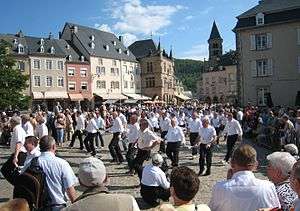Dancing procession of Echternach
The dancing procession of Echternach is an annual Roman Catholic dancing procession held at Echternach, in eastern Luxembourg. Echternach's is the last traditional dancing procession in Europe.

The procession is held every Whit Tuesday[1] around the streets of the city of Echternach. It honours Willibrord, the patron saint of Luxembourg, who established the Abbey of Echternach. Echternach has developed a strong tourism industry centred on the procession, which draws many thousands of tourists and pilgrims from around the world. The procession is inscribed in 2010 as hopping procession of Echternach on the UNESCO Representative List of the Intangible Cultural Heritage of Humanity.[2]
The procession
The event [3] begins in the morning at the bridge over the River Sauer, with a sermon delivered by the parish priest (formerly by the abbot of the monastery). "Willibrordus-Brauverein" officials put together the procession, forming several dozen alternating groups of musicians and pilgrims. The procession then moves through the town streets towards the basilica, a distance of about 1.5 kilometres (0.93 mi). While the musicians play the "Sprangprozessioùn" tune–a traditional melody, not entirely unlike an Irish jig or reel, that has been handed down through the centuries–the pilgrims, in rows of four or five abreast and holding the ends of white handkerchiefs, "dance" or "jump" from left to right and thus slowly move forward. Because of the numbers of pilgrims attending, it is well after midday before the last of the dancers has reached the church. A large number of priests, nuns, and monks also accompany the procession, and not infrequently there are several bishops as well. On arrival at the church, the dance is continued past the tomb of Saint Willibrord, which stands in the crypt beneath the high altar. Litanies and prayers in the Saint's honour are recited, and the event concludes with a benediction of the sacrament.
In the past, the dancing procession has adopted other forms. At one stage the pilgrims would take three steps forward and two steps backwards, thus taking five steps in order to advance one; at another stage the pilgrims would repeatedly stop at the sound of the bell donated by Emperor Maximilian, falling to their knees before moving forward a few more steps. Again, pilgrims would crawl under a stone, facing the cross of St. Willibrord. A 'cattle-bell dance' used to take place in front of the cross, which was erected on the marketplace; this dance was prohibited in 1664.
History
Willibrord's Abbey of Echternach was a major Christian centre in the Middle Ages, and maintained a famous library and scriptorium. However, it owes its modern fame to the quaint dancing procession. This aspect of the cult of the saint may be traced back almost to the date of his death; among the stream of pilgrims to his tomb in the abbey church have been Emperors Charlemagne, Lothair I, Conrad, and later Maximilian (in 1512).
Catholic historians are reluctant to ascribe any pre-Christian antecedents to the dancing procession, and claim only that its origin cannot be stated with certainty. There might be elements of pagan cult, such as the ones that were criticised by Saint Eligius in the 7th century. Documents of the fifteenth century speak of it as a long-established custom at that time, and a similar "dancing" procession, which used to take place in the small town of Prüm, in the Eifel, was documented as early as 1342. Legends are told that relate the dancing procession to an averted plague or offer a fable about a condemned fiddler, but the dancing procession to the saint's tomb is an annual ceremony done as an act of penance on behalf of afflicted relations and especially in order to avert epilepsy, Saint Vitus Dance, or convulsions.
The procession took place annually without intermission until 1777. There has been an uneasy relationship with the church hierarchy; in 1777, the music and dancing of the 'dancing saints' were forbidden by Archbishop Wenceslas, who declared that there should only be a pilgrim's procession, and, in 1786, Emperor Joseph II abolished the procession altogether. Attempts were made to revive it ten years later, and, although the French Revolution effectually prevented it, it was recommenced in 1802, and has continued ever since. In 1826, the government tried to change the day to a Sunday, but, since 1830, it has always taken place on Whit Tuesday, a traditional day that, significantly, bears no direct relation to St. Willibrord himself.
References
| Wikimedia Commons has media related to Dancing procession of Echternach. |
- go to WayBackMachine enter: {{cite web |url=http://www.luxembourg.co.uk/dancproc.html |title=Archived copy |accessdate=2008-06-09 |url-status=dead |archiveurl=https://web.archive.org/web/20080514151612/http://www.luxembourg.co.uk/dancproc.html |archivedate=2008-05-14 }}, select the 14th of April 2012 for The Dancing Procession of Echternach
- The hopping procession of Echternach
- "Participation, course of the procession and organisation". Archived from the original on 2010-11-22. Retrieved 2009-05-26.